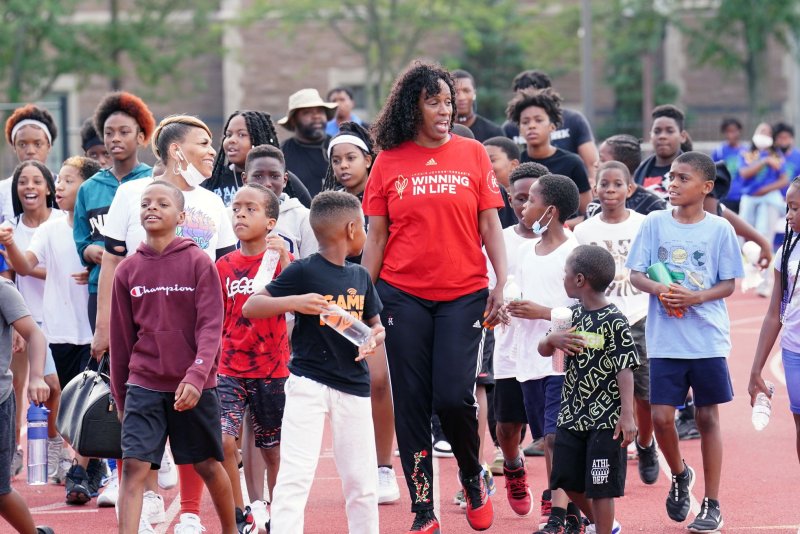Six-time Olympic medalist Jackie Joyner-Kersee walks with children on the campus of Washington University in St. Louis on June 22 in observance of World Olympic Day. A global study of children and adolescents indicates their daily physical activity decreased by roughly 20% during the height of the COVID-19 pandemic. Photo by Bill Greenblatt/UPI |
License Photo
July 11 (UPI) -- Amid America's obesity epidemic, scientific evidence is mounting that confirms parents' concerns that children too often are hanging up their cleats in favor of more screen time -- and quantifies how widespread the problem has been since the onset of the COVID-19 pandemic.
The latest evidence is a global study of 14,200 children and adolescents, which indicates that their daily physical activity dropped by roughly 20% overall during the height of the pandemic.
According to the analysis, the size of the decrease in youngsters' physical activity differed by intensity level. The duration of their daily moderate-to-vigorous physical activity fell by about 28%, or 17 minutes daily, comparing the pre-pandemic level to the level during widespread COVID-19.
In addition, the reduction in physical activity before and during the pandemic was larger -- roughly a 37% decline -- for children and adolescents living at "higher latitudes," researchers said.
They said this corresponded to regions in which pandemic restrictions "coincided with a seasonal transition into the summer months."
"This finding is consistent with pre-pandemic data showing that unstructured summer days during school holidays can have negative associations with both academic and physical health behaviors, often referred to as the 'summer slide' into physical inactivity," the researchers said in their paper.
The meta-analysis of 22 international studies, including one from the United States, on children and teens aged 18 or younger, was published Monday in JAMA Pediatrics.
Ross D. Neville, assistant professor in the School of Public Health, Physiotherapy and Sports Science at University College Dublin in Ireland, is the study's corresponding author.
Data in the meta-analysis "revealed that boys and girls of all ages and baseline activity levels experienced reductions in daily physical activity during COVID-19," researchers said in their paper.
The findings underscore the need to "sit less and play more," by improving access to support and resources for physical activity to "ensure good health and social functioning among children and adolescents during pandemic recovery efforts," the researchers added.
"Unfortunately, newly established levels of physical inactivity will be difficult to change," the research paper concludes. "The gradual lifting of public health restrictions will likely be insufficient to facilitate increases in child and adolescent physical activity. Thus, targeted public health initiatives are urgently needed."
They urged "formal reactivation strategies" to "avert the potentially irreversible harms that are being caused to a lost generation of youth."
The study is part of a spate of related research published over the past several weeks, including a study asserting that 20 minutes a day of vigorous exercise -- when children begin to sweat, their face gets red, they feel short of breath and unable to talk during the activity -- may be best for maximizing cardiorespiratory fitness in young teens.
That's in contrast to the World Health Organization's recommendation of a full hour of exercise daily -- a goal that WHO said eight in 10 adolescents didn't meet in 2016.
The American Heart Association also recommends that children and teens ages 6 to 17 get at least 60 minutes of moderate to vigorous physical activity every day.















